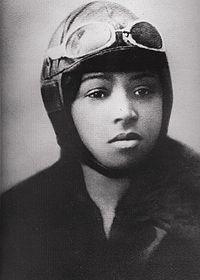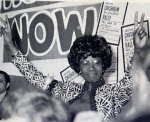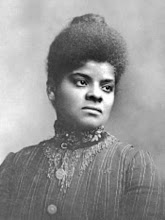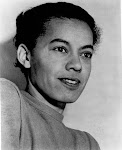When you say "Women's Aviation History" the name Amelia Earhart often comes to mind. But born before Amelia and flying before Amelia was one more beautiful black woman by the name of Bessie Coleman. Bessie got her license two years before Earhart from France. Because Coleman was black she was denied entry into US aeronautic schools that Earhart was able to attend. Consequently Bessie Coleman was the first African American woman in the world to receive an International pilot license.
Bessie Coleman was the tenth of thirteen children born in 1892 in Atlanta, Texas. She went to a one room all black school for her primary education. After her part Cherokee father left his family to seek a better life on an Indian reservation Bessie completed her high school education at a Missionary Baptist school and at 18 had one semester at the Oklahoma Colored Agricultural and Normal University (now called Langston University). She ran out of money to further her education so she moved to Chicago to stay with her two brothers. Coleman then attended beauty school and got a job as a manicurist. It was in Chicago that she began to consider a career in aviation. Coleman's brother shared stories of his service during World War I and noted the many French women who flew and were supposedly "superior" to her who would never fly. Such stories only strengthened Bessie Coleman's resolve.
She couldn't gain entry into any of the American aviation schools because she was black and in addition to that a female. On the advice and part sponsorship of Robert S. Abbott, the black owner of "The Chicago Defender" an African American weekly newspaper, she saved some money, took french classes at the Berlitz school and went to France. She was trained at the Fédération Aéronautique Internationale in November 1920.
On June 15, 1921 she became the first African American woman in the world to get an international pilot license.
Upon returning to the States Coleman realized that she would only be able to earn a living as a stunt flyer so she went back to France and then Holland for additional training. She then returned to the States where she made a name for herself doing airshows. A great crowd-pleaser, people began to call her Queen Bessie. She used her fame to affect racial discrimination as much as she could. When she returned to her hometown to perform Coleman refused to do so unless both blacks and whites went through the same ticket gates. She also turned down a movie role because she would have to demean her appearance in the movie to support stereotypes of African Americans. She dreamed of running an aviation school of her own to train other black pilots but this was thwarted by an accident in Jacksonville Florida in 1926. Her mechanic accidentally left a wrench in the engine area of the plane which jammed the gearbox during flight and caused the plane to spin out of control killing both Bessie Coleman and her mechanic William Wills.
The effect of her life on African Americans and aviation was evident after her death. Thousands of mourners attended her funeral including several important black leaders like Ida B. Wells. Several Bessie Coleman flying clubs were created and in 1931 a group of African American pilots established an annual flyover for Coleman's grave.
In 1995 Bessie Coleman was inducted into the Women in Aviation Hall of Fame and put on a US postal stamp. So the next time women in aviation comes up think Bessie Coleman first. She flew first.
Wednesday, June 9, 2010
Tuesday, June 1, 2010
The First Black Presidential Candidate
"The United States was said not to be ready to elect a Catholic to the Presidency when Al Smith ran in the 1920's. But Smith's nomination may have helped pave the way for the successful campaign John F. Kennedy waged in 1960. Who can tell? What I hope most is that now there will be others who will feel themselves as capable of running for high political office as any wealthy, good-looking white male." --Shirley Chisholm.
This woman who with her incisive wit, drive, courage and foresight cut a path for Barack Obama and all blacks to the Oval office of the White House was a first generation American of Barbadian descent born in Brooklyn, NY, in 1924. At three she was sent to her grandmother in Barbados for a few years which she credits with her educational success for starting her off with a traditional British styled education. Then she returned to America at the height of the Depression at age ten. When it came time to go to college she was accepted to several great ones with tuition scholarships but unable to afford the room and board Chisholm attended Brooklyn college instead. She received her BA in 1946 and later an MA in elementary education from Columbia in 1952.
"One distressing thing is the way men react to women who assert their equality: their ultimate weapon is to call them unfeminine. They think she is anti-male; they even whisper that she's probably a lesbian."-- Shirley Chisholm
It was while she was on campus that Chisholm first became active in various campus groups. Later on while working in the educational field she became active with the Democratic Party fighting for women and blacks. As the Civil Rights movement swell crested Chisholm decided to run for The New York State assembly and was elected in 1964 where she sponsored fifty bills. In 1968 she was the first black woman elected into the House of Congress and in 1972 was the first black presidential candidate. After failing to win she was voted one of the ten most admired women in the world and continued in Congress until she retired in 1982. Chisholm fought for justice and equality on many fronts by speaking out on topics such as police brutality, prison reform, and a woman's right to choose. She earned a reputation as a challenger of the status quo.
Shirley Chisholm was married twice. First to Conrad Chisholm (1949-1977) and then to Arthur Hardwick Jr., who died in 1986. Shirley died in 2005.
You can learn more about Shirley Chisholm by reading "Chisholm '72 - Unbought & Unbossed."
"I want history to remember me not just as the first black woman to be elected to Congress, not as the first black woman to have made a bid for the presidency of the United States, but as a black woman who lived in the 20th century and dared to be herself." -- Shirley Chisholm
This woman who with her incisive wit, drive, courage and foresight cut a path for Barack Obama and all blacks to the Oval office of the White House was a first generation American of Barbadian descent born in Brooklyn, NY, in 1924. At three she was sent to her grandmother in Barbados for a few years which she credits with her educational success for starting her off with a traditional British styled education. Then she returned to America at the height of the Depression at age ten. When it came time to go to college she was accepted to several great ones with tuition scholarships but unable to afford the room and board Chisholm attended Brooklyn college instead. She received her BA in 1946 and later an MA in elementary education from Columbia in 1952.
"One distressing thing is the way men react to women who assert their equality: their ultimate weapon is to call them unfeminine. They think she is anti-male; they even whisper that she's probably a lesbian."-- Shirley Chisholm
It was while she was on campus that Chisholm first became active in various campus groups. Later on while working in the educational field she became active with the Democratic Party fighting for women and blacks. As the Civil Rights movement swell crested Chisholm decided to run for The New York State assembly and was elected in 1964 where she sponsored fifty bills. In 1968 she was the first black woman elected into the House of Congress and in 1972 was the first black presidential candidate. After failing to win she was voted one of the ten most admired women in the world and continued in Congress until she retired in 1982. Chisholm fought for justice and equality on many fronts by speaking out on topics such as police brutality, prison reform, and a woman's right to choose. She earned a reputation as a challenger of the status quo.
Shirley Chisholm was married twice. First to Conrad Chisholm (1949-1977) and then to Arthur Hardwick Jr., who died in 1986. Shirley died in 2005.
You can learn more about Shirley Chisholm by reading "Chisholm '72 - Unbought & Unbossed."
"I want history to remember me not just as the first black woman to be elected to Congress, not as the first black woman to have made a bid for the presidency of the United States, but as a black woman who lived in the 20th century and dared to be herself." -- Shirley Chisholm
Thursday, May 20, 2010
Education For a Higher Calling
A Washington DC native born in 1893, Eva Beatrice Dykes was one of three African American women who, all in 1921, were the first African American women to received their PhDs. Her degree was in English from Radcliffe College at Harvard, where she had also received a Masters and second Bachelors after completing a Bachelors at Howard University. With this distinction Eva could have chosen one of a few unprecedented paths before her but in keeping with her character chose to pursue a life of service to her people and God. A devout Seventh Day Adventist member Eva was guided by her desire to be the best she could be in service to others through God's will.
The defining aspects of her life were her trail blazing academic accomplishments and her involvement in the development of the Seventh-Day Adventist church for black members. In fact her acceptance of a teaching position at Howard University was contingent on their understanding her religious obligations which included keeping the Sabbath from Friday sundown to Saturday sundown. In addition to this she helped form the National Association for the Advancement of World-wide Work Among Colored Seventh-day Adventists on October 16, 1943 to address racial discrimination in the SDA church.
This religious dedication permeated her whole life and most remarkable about her career path is the selfless way she choose to resign her position at Howard University in D.C. and take up permanent tenure at a small black Seventh Day Adventist college in Huntsville, Alabama. This happened in1944. A time when Huntsville had little to recommend it in comparison to the nation's capital. But she believed it was the greater need and therefore the path of greater service to God and her people. Her move to Oakland facilitated its move to becoming an accredited college. This answer to a higher call to a purpose driven life influenced her choices and goals as she believed that it was only when you resisted God that you remained nothing.
She was also considered a child prodigy who was gifted as a pianist and organist. She founded at Oakland College (now Oakland University) the Aeolian Choral Group in 1946, which performed Handel's Messiah and presently performs a range of music from the Baroque era to the twentieth century as well as Negro spirituals and work songs. The choir has since achieved world wide fame and performed at the Kennedy Center in D.C. , Good Morning America and several concerts in the US, Canada, Bermuda, the Bahamas, Romania, Poland and UK
Dedicating over half a century to education and writing articles and books she was recognized for work as an educator and wrote the book "The Negro in English Romantic Thought." She died in Huntsville, Alabama on Oct. 29th, 1986 at 93 years of age.
You can learn more about Eva Beatrice Dykes by reading the book "She fulfilled the Impossible Dream" by Dewitt S. Williams, and visiting the Oakland University website.
The defining aspects of her life were her trail blazing academic accomplishments and her involvement in the development of the Seventh-Day Adventist church for black members. In fact her acceptance of a teaching position at Howard University was contingent on their understanding her religious obligations which included keeping the Sabbath from Friday sundown to Saturday sundown. In addition to this she helped form the National Association for the Advancement of World-wide Work Among Colored Seventh-day Adventists on October 16, 1943 to address racial discrimination in the SDA church.
This religious dedication permeated her whole life and most remarkable about her career path is the selfless way she choose to resign her position at Howard University in D.C. and take up permanent tenure at a small black Seventh Day Adventist college in Huntsville, Alabama. This happened in1944. A time when Huntsville had little to recommend it in comparison to the nation's capital. But she believed it was the greater need and therefore the path of greater service to God and her people. Her move to Oakland facilitated its move to becoming an accredited college. This answer to a higher call to a purpose driven life influenced her choices and goals as she believed that it was only when you resisted God that you remained nothing.
She was also considered a child prodigy who was gifted as a pianist and organist. She founded at Oakland College (now Oakland University) the Aeolian Choral Group in 1946, which performed Handel's Messiah and presently performs a range of music from the Baroque era to the twentieth century as well as Negro spirituals and work songs. The choir has since achieved world wide fame and performed at the Kennedy Center in D.C. , Good Morning America and several concerts in the US, Canada, Bermuda, the Bahamas, Romania, Poland and UK
Dedicating over half a century to education and writing articles and books she was recognized for work as an educator and wrote the book "The Negro in English Romantic Thought." She died in Huntsville, Alabama on Oct. 29th, 1986 at 93 years of age.
You can learn more about Eva Beatrice Dykes by reading the book "She fulfilled the Impossible Dream" by Dewitt S. Williams, and visiting the Oakland University website.
Tuesday, March 30, 2010
Forever Giving
This week’s beautiful black woman is Henrietta Lacks (August 1, 1920- October 4, 1951). During her lifetime Lacks was an unknown tobacco farmer born and raised in southern Virginia. She was one of ten children born to Eliza and John Pleasant. Lacks married David Lacks and bore five children. In 1943 she and her family moved to Baltimore where she lived until her death.
In February, 1950 at age 30 Lacks was diagnosed with cervical cancer. During her treatment at John Hopkins Hospital doctors removed part of her tumor without her consent and began using her cells for medical research. Dr. George Gey discovered that Henrietta Lack’s cells were eternally viable in the laboratory and could be mass produced. Lack’s cells were the first human cells found capable of surviving outside of the body FOREVER. Normal cells had a lifespan but Henrietta's cell's were immortal. This was clearly a milestone for medicine. Dr. Gey named the cells HeLa and they were immediately cultured and used for medical research. Lacks died just eight months later for the cancer. Just three years after Henrietta Lack’s death, HeLa cells were used by the famous Dr. Jonas Salk to find the polio vaccine. Since then, Hela cells have been used worldwide in medical research.
The crazy piece of this story is that while HeLa cells were being produced and sold in laboratories all over the world the Lack’s family was unaware of HeLa for over twenty years. In 2001 the National Foundation for Cancer Research announced plans to honor Henrietta lack’s contribution to medicine but plans were derailed with the events of 9/11.
This past February scientist Rebecca Skloot published The Immortal Life of Henrietta Lacks with Crown books. It is the first biography of Henrietta Lacks and has drawn renewed attention to this medical milestone and the woman behind it all.
Learn more about Hernietta by visiting Skloot’s website.
You can also read a good interview on Smithsonian online magazine
In February, 1950 at age 30 Lacks was diagnosed with cervical cancer. During her treatment at John Hopkins Hospital doctors removed part of her tumor without her consent and began using her cells for medical research. Dr. George Gey discovered that Henrietta Lack’s cells were eternally viable in the laboratory and could be mass produced. Lack’s cells were the first human cells found capable of surviving outside of the body FOREVER. Normal cells had a lifespan but Henrietta's cell's were immortal. This was clearly a milestone for medicine. Dr. Gey named the cells HeLa and they were immediately cultured and used for medical research. Lacks died just eight months later for the cancer. Just three years after Henrietta Lack’s death, HeLa cells were used by the famous Dr. Jonas Salk to find the polio vaccine. Since then, Hela cells have been used worldwide in medical research.
The crazy piece of this story is that while HeLa cells were being produced and sold in laboratories all over the world the Lack’s family was unaware of HeLa for over twenty years. In 2001 the National Foundation for Cancer Research announced plans to honor Henrietta lack’s contribution to medicine but plans were derailed with the events of 9/11.
This past February scientist Rebecca Skloot published The Immortal Life of Henrietta Lacks with Crown books. It is the first biography of Henrietta Lacks and has drawn renewed attention to this medical milestone and the woman behind it all.
Learn more about Hernietta by visiting Skloot’s website.
You can also read a good interview on Smithsonian online magazine
Subscribe to:
Posts (Atom)






